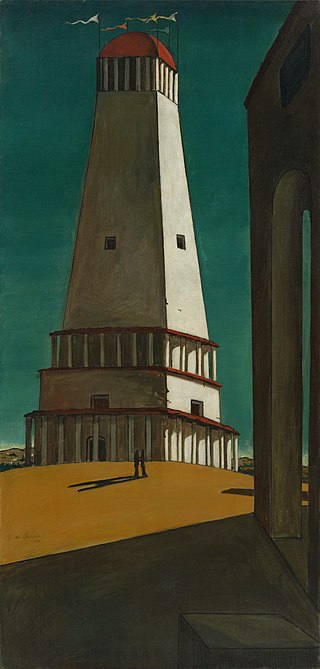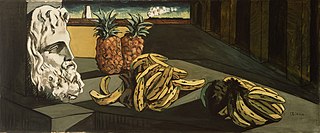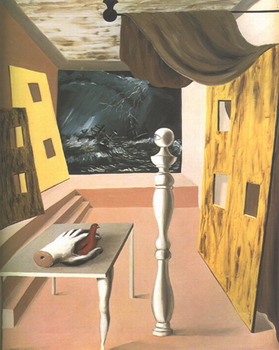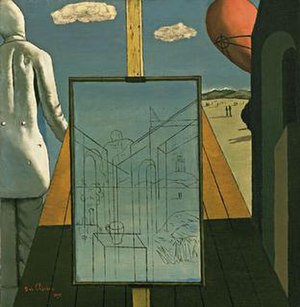
The history of painting reaches back in time to artifacts and artwork created by pre-historic artists, and spans all cultures. It represents a continuous, though periodically disrupted, tradition from Antiquity. Across cultures, continents, and millennia, the history of painting consists of an ongoing river of creativity that continues into the 21st century. Until the early 20th century it relied primarily on representational, religious and classical motifs, after which time more purely abstract and conceptual approaches gained favor.

Giuseppe Maria Alberto Giorgio de Chirico was an Italian artist and writer born in Greece. In the years before World War I, he founded the scuola metafisica art movement, which profoundly influenced the surrealists. His best-known works often feature Roman arcades, long shadows, mannequins, trains, and illogical perspective. His imagery reflects his affinity for the philosophy of Arthur Schopenhauer and of Friedrich Nietzsche, and for the mythology of his birthplace.

Raymond Georges Yves Tanguy, known as just Yves Tanguy, was a French surrealist painter.

Paul Delvaux was a Belgian painter noted for his dream-like scenes of women, classical architecture, trains and train stations, and skeletons, often in combination. He is often considered a surrealist, although he only briefly identified with the Surrealist movement. He was influenced by the works of Giorgio de Chirico and René Magritte, but developed his own fantastical subjects and hyper-realistic styling, combining the detailed classical beauty of academic painting with the bizarre juxtapositions of surrealism.

Balthasar Klossowskide Rola, known as Balthus, was a Polish-French modern artist. He is known for his erotically charged images of pubescent girls, but also for the refined, dreamlike quality of his imagery.

Since ancient times, Greeks, Etruscans and Celts have inhabited the south, centre and north of the Italian peninsula respectively. The very numerous rock drawings in Valcamonica are as old as 8,000 BC, and there are rich remains of Etruscan art from thousands of tombs, as well as rich remains from the Greek colonies at Paestum, Agrigento and elsewhere. Ancient Rome finally emerged as the dominant Italian and European power. The Roman remains in Italy are of extraordinary richness, from the grand Imperial monuments of Rome itself to the survival of exceptionally preserved ordinary buildings in Pompeii and neighbouring sites. Following the fall of the Roman Empire, in the Middle Ages Italy remained an important centre, not only of the Carolingian art, Ottonian art of the Holy Roman Emperors, Norman art, but for the Byzantine art of Ravenna and other sites.

Paul Nash was a British surrealist painter and war artist, as well as a photographer, writer and designer of applied art. Nash was among the most important landscape artists of the first half of the twentieth century. He played a key role in the development of Modernism in English art.

Carlo Carrà was an Italian painter and a leading figure of the Futurist movement that flourished in Italy during the beginning of the 20th century. In addition to his many paintings, he wrote a number of books concerning art. He taught for many years in the city of Milan.

The Nostalgia of the Infinite is a painting by Italian metaphysical painter Giorgio de Chirico, dated of 1911, but most likely painted in 1912-113.

The Song of Love is a 1914 painting by Italian metaphysical painter Giorgio de Chirico. It is one of the most famous works by Chirico and an early example of his pre-surrealist style, though it was painted ten years before the movement was "founded" by André Breton in 1924.

Gare Montparnasse (The Melancholy of Departure) (Italian: La stazione di Montparnasse) is an oil on canvas painting by the Italian metaphysical painter Giorgio de Chirico, from 1914. It is held at the Museum of Modern Art, in New York.

The Disquieting Muses is a painting by the Italian metaphysical painter Giorgio de Chirico. There are two versions of this painting, the original is in the Gianni Mattioli private collection, in Milan, and the other is at the Pinakothek der Moderne, in Munich.

Modern Greek art is art from the period between the emergence of the new independent Greek state and the 20th century. As Mainland Greece was under Ottoman rule for all four centuries, it was not a part of the Renaissance and artistic movements that followed in Western Europe. However, Greek islands such as Crete, and the Ionian islands in particular were for large periods under Venetian or other European powers' rule and thus were able to better assimilate the radical artistic changes that were occurring in Europe during the 14th-18th century.

'The Transformed Dream is an oil on canvas painting by the Italian metaphysical painter Giorgio de Chirico, from 1913. It is held at the Saint Louis Art Museum, in St. Louis.

The Difficult Crossing(La traversée difficile) is the name given to two oil-on-canvas paintings by the Belgian surrealist René Magritte. The original version was completed in 1926 during Magritte's early prolific years of surrealism and is currently held in a private collection. A later version was completed in 1963 and is also held in a private collection.
The Eighteen Arhats are depicted in Chinese Buddhism as the original followers of Gautama Buddha (arhat) who have followed the Noble Eightfold Path and attained the four stages of enlightenment. They have reached the state of Nirvana and are free of worldly cravings. They are charged to protect the Buddhist faith and to wait on earth for the coming of Maitreya, an enlightened Buddha prophesied to arrive on earth many millennia after Gautama Buddha's death (parinirvana). In China, the eighteen arhats are also a popular subject in Buddhist art, such as the famous Chinese group of glazed pottery luohans from Yixian from about 1000 CE.

Morohashi Museum of Modern Art is an art museum that opened in Kitashiobara, Fukushima Prefecture, Japan, in 1999. It is situated within Bandai-Asahi National Park, near Goshiki-numa, and with views of Mount Bandai. The permanent collection includes over three hundred forty pieces by Salvador Dalí, which makes it the third largest Dalí Museum in the world and the sole Dalí Museum in Asia. It also owns works by other painters, like Sisley, Cézanne, Renoir, Matisse and Picasso.

The Soothsayer's Recompense is a 1913 painting by Italian painter Giorgio de Chirico. It is now in the Philadelphia Museum of Art as part of the permanent collection. It was accessioned in 1950 as one of the thousand items donated to the institution by Walter and Louise Arensberg. The piece was created in France, through a process of "squaring-up" in which Chirico drew a version of the piece divided into nine squares, and subsequently used this draft to quickly create the fleshed-out painting.

The Temple is a painting made in 1949 by the Belgian artist Paul Delvaux. It depicts a classical temple building in moonlight, with the head of a statue and several modern objects in the foreground. The painting was made in Choisel outside Paris where Delvaux lived temporarily with his lover and future wife Anne-Marie "Tam" de Maertelaere. It is an oil painting with the dimensions 113.7 cm × 146 cm.


















